Summary
-
1.
Interactions among bumble bee workers (Bombus terricola Kirby andB. vagans Smith) occurred on roses (Rosa carolina), a rich source of pollen.
-
2.
Bombus terricola workers were larger, on the average, thanB. vagans workers. The two species displaced each other with similar frequency, but where individuals of similar size were involved,B. vagans usually prevailed overB. terricola.
-
3.
Interspecific encounters did not differ from intraspecific encounters in any other detectable way.
-
4.
Workers of both species never foraged together in the same flower.
Zusammenfassung
-
1.
Auf Blüten der RoseRosa carolina (eine ergiebige Pollenquelle) wurden Interaktionen zwischen Arbeiterinnen der HummelartenBombus terricola Kirby undB. vagans Smith beobachtet.
-
2.
Treffen Arbeiterinnen gleicher Größe zusammen, so siegt in der RegelB. vagans überB. terricola. Trotzdem verdrängen sich die beiden Arten mit nahezu gleicher Häufigkeit, da die Arbeiterinnen vonB. terricola im Durchschnitt größer sind als die vonB. vagans.
-
3.
Interspezifische Auseinandersetzungen waren von intraspezifischen nicht zu unterscheiden.
-
4.
Bei beiden Arten sammeln niemals mehrere Arbeiterinnen zugleich an derselben Blüte.
Similar content being viewed by others
References
Benedek (P.), Manninger (S.) andDévai (G.), 1971. — Lucerna és vöröshere megaporzási kísérletek háziméhekkel.Növénytermelés, 20, 145–156. (Hungarian with English summary).
Benest (G.), 1976. — Relations interspécifiques et intraspécifiques entre butineuses deBombus sp. et d'Apis mellifica L.Apidologie, 7, 113–127.
Brian (A. D.), 1957. — Differences in the flowers visited by four species ofBombus.J. Anim. Ecol., 26, 71–98.
Free (J. B.) andButler (C. G.), 1959. — Bumblebees.Collins, Publ., London, 208 p.
Heinrich (B.), 1976. — Resource partitioning among some eusocial insects: bumblebees.Ecology, 57, 874–889.
Inouye (D. W.), 1976. — Resource partitioning and community structure: a study of bumble bees in the Colorado Rocky Mountains. Ph. D. dissertation,Univ. of North Carolina, Chapel Hill, 1978, 127 p. Resource partitioning in bumble bees: experimental studies of foraging behavior.Ecology, in press.
Johnson (L. K.) andHubbell (S. P.), 1974. — Aggression and competition among stingless bees: field studies.Ecology, 55, 120–127.—Johnson (L. K.), andHubbell (S. P.), 1975. Contrasting foraging strategies and coexistence of two bee species on a single resource,Ecology, 56, 1398–1406.
Jones (L. G.), 1950. — Increased production of alfalfa seed through honey-bee pollination.Report 12th Alfalfa Improvement Congr., 38–40.
Kikuchi (T.), 1965. — Role of interspecific dominance-subordination relationship on the appearance of flower-visiting insects.Sci. Rep. Tôhoku Univ. Ser. IV. (Biol.), 31, 275–296.
Michener (C. D.), 1974. — The social behavior of the bees.Belknap Press, Publ., Cambridge, Mass., 404 p.
Miller (R. S.), 1967. — Pattern and process in competition.Adv. Ecol. Res., 4, 1–74.
Morse (D. H.), 1974. — Niche breadth as a function of social dominance.Am. Natur. 108, 818–830.—Morse (D. H.) 1977. Estimating proboscis length from wing length in bumblebees (Bombus spp.).Ann. Entomol. Soc. Am., 70, 311–315. The effect of reward size on foraging patterns of bumble bees.Ecology (MS submitted).
Plath (O. E.), 1934. — Bumblebees and their ways.MacMillan, Publ. New York, 201 p.
Weaver (N.), 1957. — The foraging behavior of honeybees on hairy vetch. II. The foraging area and foraging speed (1).Ins. Soc., 4, 43–57.
Author information
Authors and Affiliations
Rights and permissions
About this article
Cite this article
Morse, D.H. Interactions among bumble bees on roses. Ins. Soc 25, 365–371 (1978). https://doi.org/10.1007/BF02224300
Received:
Accepted:
Issue Date:
DOI: https://doi.org/10.1007/BF02224300




